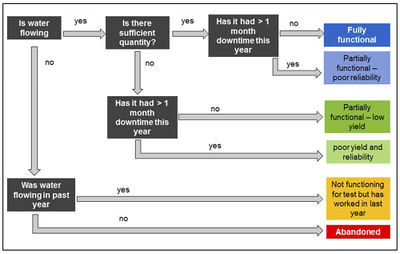OR/16/044 Defining functionality - different levels of performance
| Wilson P, Bonsor H C, MacDonald A M, Whaley L, Carter R C, Casey V. 2016. UPGRO Hidden Crisis Research consortium: initial project approach for assessing rural water supply functionality and levels of performance. British Geological Survey (BGS) Open Report, OR/16/044. |
 |
Taking the findings from the literature review, the discussions with partners at our project workshop (Appendix 2), and developing thinking from an earlier paper (Carter and Ross 2016)[1], the following framework for assessing functionality is proposed by the project. The results of the first survey phase of the project — a rapid survey of 600 hand‐pump boreholes supplies across the three countries — will be used to review this proposed approach, and to inform the final approach proposed by the project to assess HPB functionality, alongside a requisite set of indicators.
Guidelines for assessing functionality
Within Hidden Crisis Project we suggest the following guidelines for assessing functionality:
- Functionality should be measured against an explicitly stated standard and population of water points.
- It should be measured separately from the users experience of the service it provides.
- The assessments should be tiered, allowing for further information, but always being able to be reduced to a simple measure.
- A distinction can be made between surveying functionality as a snapshot (e.g. for national metrics) and monitoring individual water point performance (including a temporal aspect).
Defining functionality
The Hidden Crisis project has applied these guidelines to develop a framework approach to define functionality in terms of different levels of performance. This starts with a basic ‘working yes/no’ definition, and moves to a more detailed understanding of the reliability and yield of supply — Figure 3. The final level introduces water quality to the performance assessment. As such the project examines the following definitions of functionality:
- Basic — is the water point working (yes/no)
- Snapshot — does the water point work and provide sufficient yield (10 L/min)
- Functionality performance — (provides sufficient and reliability (<30 days downtime in last year))
- Functionality including water quality — (passes WHO inorganic parameters, and TTC)
Each of these definitions requires different amounts of data to be collected, and a requisite duration of survey. The ‘Basic’ and ‘Snapshot’ assessments reflect the requirements of national survey assessments, whilst the more performance‐focused definitions are more relevant to local or regional surveys looking to track the functionality of individual water points or programmes through time.
Standard approaches will be used to assess the different levels of functionality within the project.

Reference
- ↑ Carter, R, Ross, I. (2016). Beyond 'Functionality' of handpump‐supplied rural water services in developing countries. Waterlines, 35(1) 94–110.